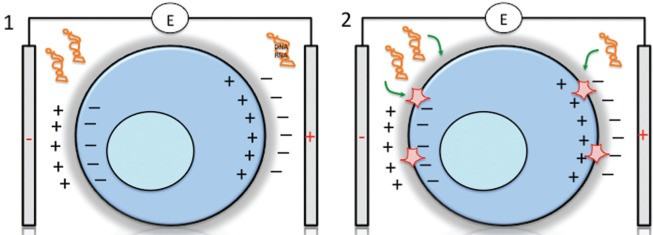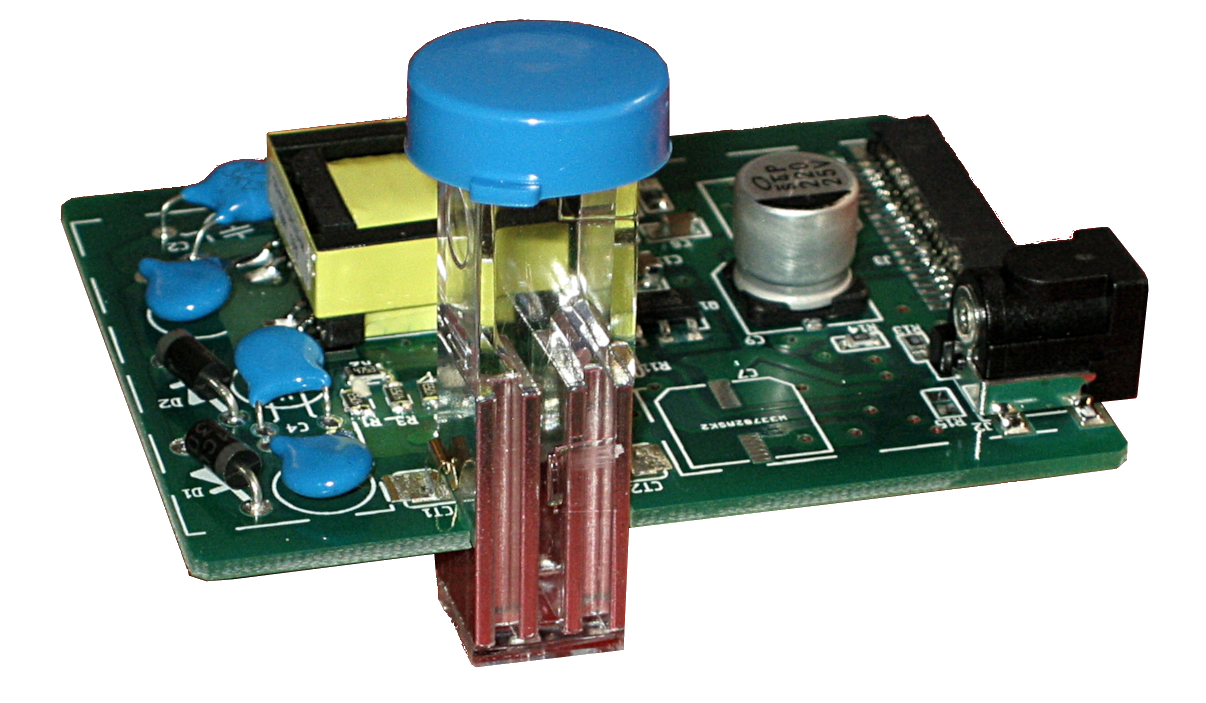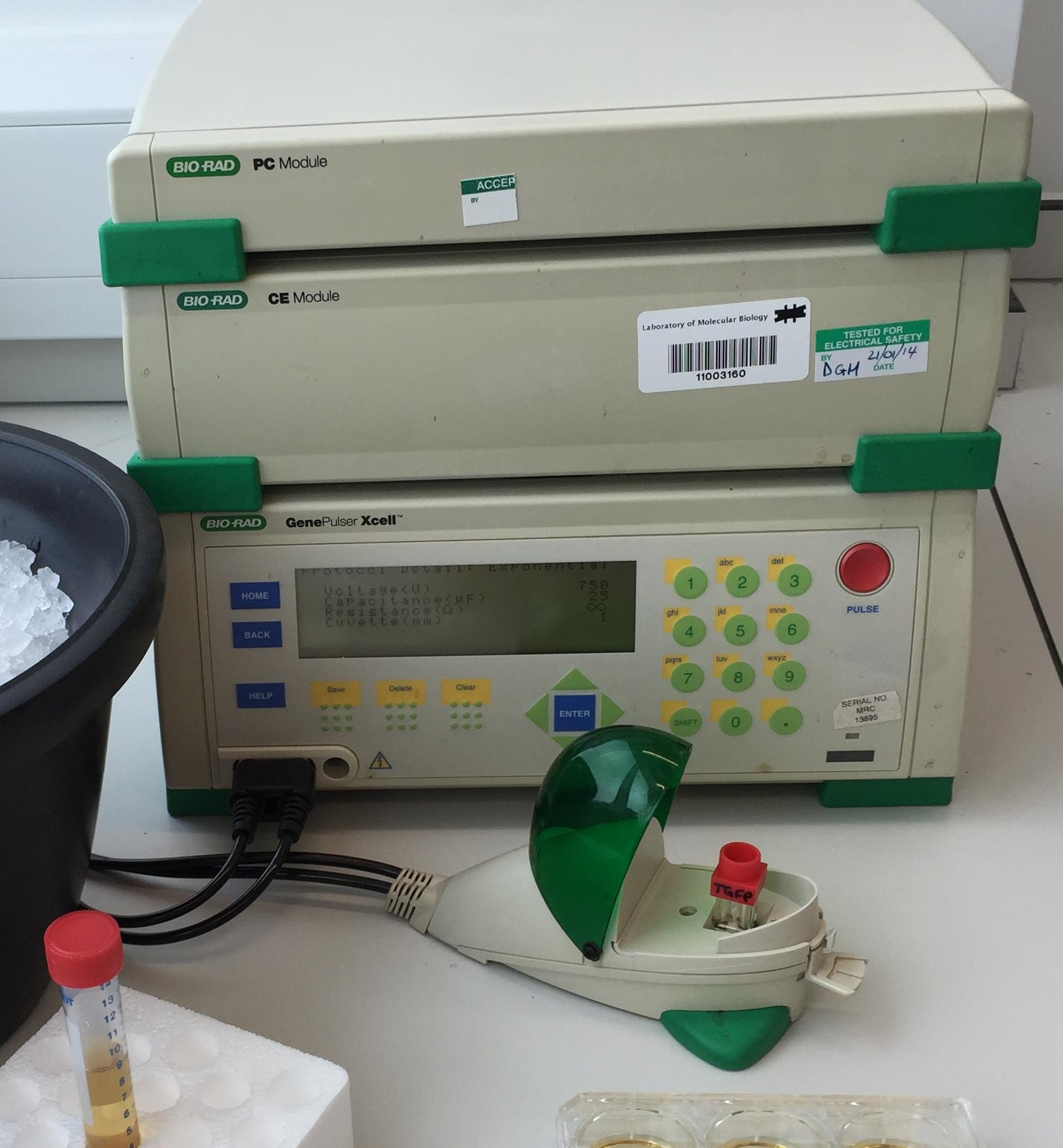The classical electroporator delivers a voltage from a charged capacitor bank connected across parallel plates with a suspension of cells between them. When the capacitor energy discharges, the field strength makes the cell walls open up.
 Figure 1. from: Electroporation Knows no Boundaries1
fig 2.
Figure 1. from: Electroporation Knows no Boundaries1
fig 2.
There are some visual descriptions on the net of molecule lipid layers in cell walls breaching during electroporation, and many diagrams of cell walls with holes in them:
 Figure 2. hydrophobic pore, hydrophilic pore2
Figure 2. hydrophobic pore, hydrophilic pore2
The early theory of pore formation 5 is based on cells with plenty of water or buffer solution around them, not packed rubbing against each other, and says pores form with enough volts, then get bigger as pulse duration is longer, with 10 milliseconds being too long, 1 millisecond being about right and electroporation onset generally occurs if the transmembrane voltage reaches 0.5-1.5 V. -- (see footnote 5 for more).
For many months now a few collaborators have been developing a new tool called Culture Shock that gives more function at a tenth of the price compared to any new electroporators for sale now. Bryan Bishop named the project and paid for some of it. John Griessen, (the author), does product design and manufacturing with less money and more performance in mind. Others who met talking on diybio@googlegroups.com help by beta testing and by being early adopter buyers -- Nathan, Alvaro, Keoni and William might write up using their v0.1 Culture Shock electroporators here soon.
 Figure 3. Culture Shock v0.1 kvboard assembly
Figure 3. Culture Shock v0.1 kvboard assembly
Does electroporation in a cuvette work well enough? For cases where the DNA to use is plentiful and the quantities of transformed cells desired are modest, a standard cuvette "just works". If you want more quantity for a manufacturing process or a large research goal, small cuvettes are limiting. We want a good voltage level to be found and used easily so survival rates are high too. What we at kitmatic think about the field strength and volt levels is that many factors such as cell density and buffer conductivity and cell species variation make it hard to know. For the case of cells floating far apart from each other in a medium with more conductivity than the cells, the field strength for electroporation is in a known range but varies from one species of cell to another, so trial and error is the usual method of determining a volt profile recipe for electroporating. When you have a recipe chosen, there is still the question, "How much of my DNA will get in?".
Stirring and multiple voltage pulses over time help make pores all around each cell wall, so DNA gets in via more pores before they reseal. We will be experimenting with recipes that pulse the sample then wait for brownian motion to rotate cells around some, then pulse again and repeat several times towards a goal of getting pores all around a cell's perimeter. Besides transformation efficiency by creating pores, there is surviving to consider -- too high a voltage or too long a pulse rips such holes in cells they don't recover. A future project goal will be to add vibratory stirring and flow path stirring and High volts followed by mild volts, (Flow-through electroporation sec 3.1), to help with getting your DNA in.
For the old school electroporator such as the toolbox sized Gene Pulser of the 80's, that triggers a capacitor discharge, the highest voltage is at the very start. That kind of machine has no way to keep the voltage constant for any programmed time since it is always exponentially decaying. Its more recent variant pictured below...
 from: Dictyostelium Cultivation, Transfection, Microscopy and Fractionation2,3
fig 2.
from: Dictyostelium Cultivation, Transfection, Microscopy and Fractionation2,3
fig 2.
can store recipes, and output square pulses, but cannot deliver over 500V more than twice with at least 5 seconds between, so not good for experimenting with maximum electroporation by pulse trains and it takes up so much room on the bench...
The Culture Shock electroporator is able to hold the voltage up for some tens of milliseconds -- much longer than needed for a batch electroporation. With close control of the peak voltage and thus the field strength a live cell experiences "just enough" E field so its cell wall rips open, but not too far, then heals in seconds to minutes, (much slower than it opens). The high voltage pulse the new machine can deliver will have small variations in a sawtooth shape but be up for as long as programmed, so maybe we can use lower peak voltages to get a desired transformation yield. With more experimentation all of us will discover recipe voltage thresholds and programmed pulse trains which get a good electroporation effect for particular types of cells and cell suspension concentrations and not give it too much which might kill more cells. If "old school" exponential discharge pulse shape is desired to repeat a protocol, that can be programmed as well as pulse trains. Culture Shock's innovation really is programming by the user of most any milliseconds pulse shape delivered with an inexpensive handheld sized electroporator. Work on ergonomics of the instrument case and safety for the user will be going strong during July, so please stay tuned.
Footnotes
Electroporation Knows No Boundaries: The Use of Electrostimulation for siRNA Delivery in Cells and Tissues J Biomol Screen. 2015 Sep; 20(8): 932–942. doi: 10.1177/1087057115579638
protocol was used:By MDougM - Own work, Public Domain, https://commons.wikimedia.org/w/index.php?curid=5946526
Hirst, J., Kay, R. R. and Traynor, D. (2015). Dictyostelium Cultivation, Transfection, Microscopy and Fractionation. Bio-protocol 5(11): e1485. DOI: 10.21769/BioProtoc.1485; Full Text
Hirst, J., Schlacht, A., Norcott, J. P., Traynor, D., Bloomfield, G., Antrobus, R., Kay, R. R., Dacks, J. B. and Robinson, M. S. (2014). Characterization of TSET, an ancient and widespread membrane trafficking complex. Elife 3: e02866.
Dr. James C. Weaver Electroporation: A general phenomenon for manipulating cells and tissues Journal of Cellular Biochemistry Volume 51, Issue 4, pages 426–435, 1 April 1993